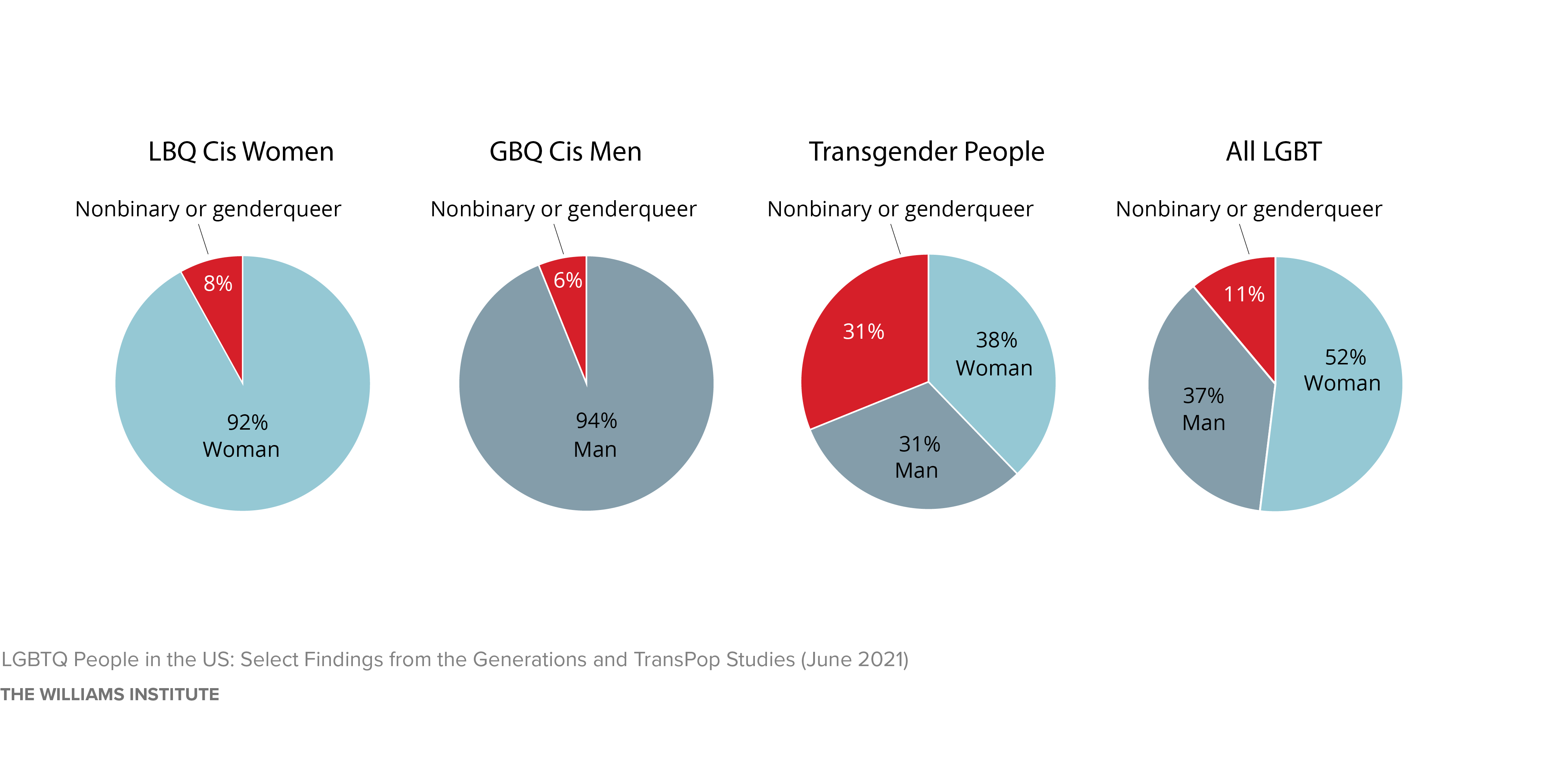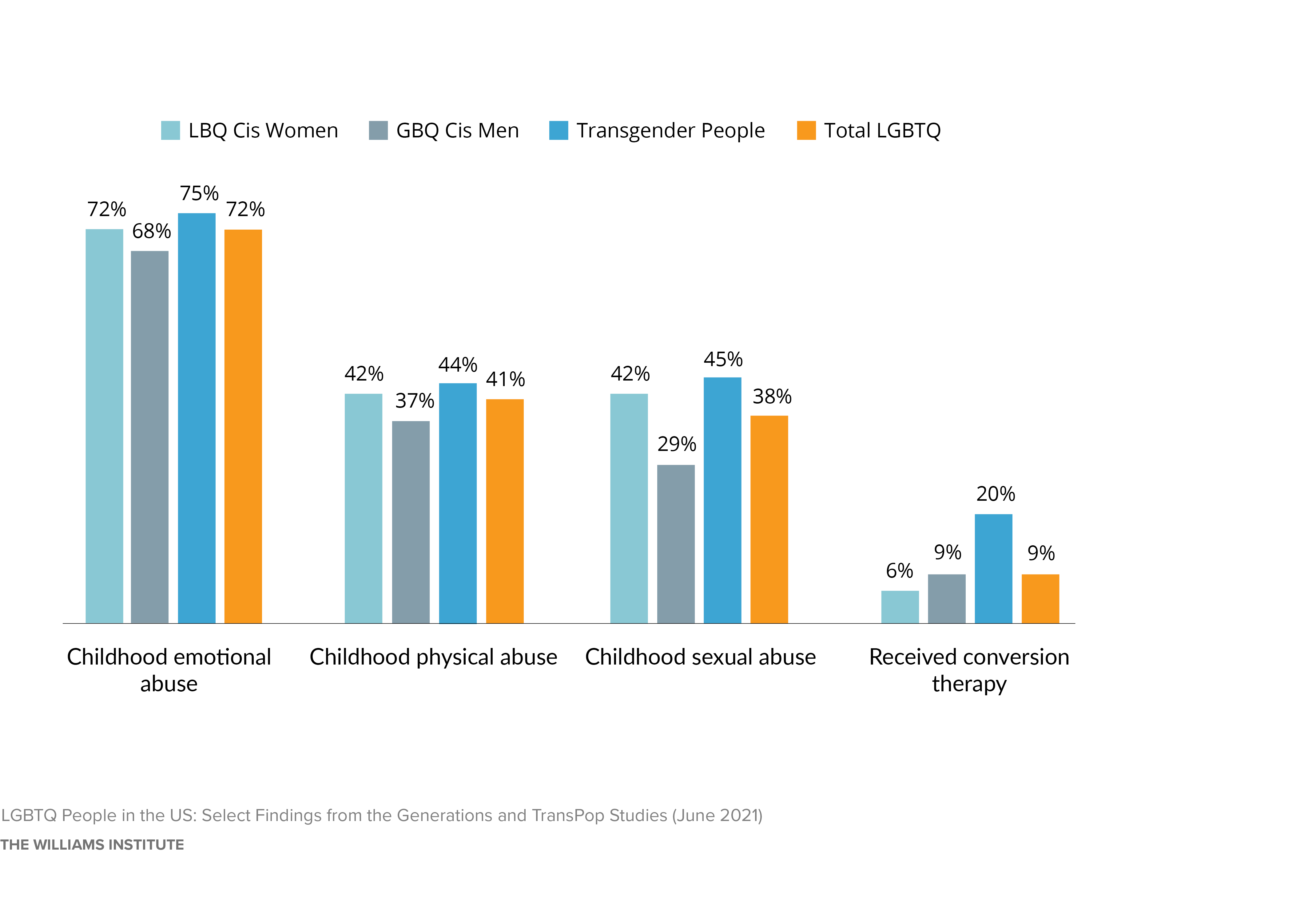LGBTQ People in the US: Select Findings from the Generations and TransPop Studies
This report presents topline findings from the Generations and TransPop studies. It examines similarities and differences across a variety of LGBTQ-relevant topics among key subgroups of LGBTQ people—GBQ cisgender men, LBQ cisgender women, and transgender people.
Executive Summary
During the last two decades, the United States has seen an increase in knowledge about the demographics of LGBTQ people. This consistent flow of data is due in large part to the increase in the collection of sexual orientation and gender identity (SOGI) data in population surveys, such as those coordinated by the Centers for Disease Control and Prevention. Yet, these datasets rarely include any information about topics that are uniquely relevant to LGBTQ people and other marginalized groups, such as identity development, relationships, sense of community, and discrimination. Numerous studies by scholars and advocacy organizations detail findings on many of these topics; however, they are limited by convenience (nonrandom) approaches to finding participants, as well as by small or regional sample sizes.
This report summarizes major descriptive findings on these LGBTQ-relevant topics, as well as basic demographics and health information from the first LGBTQ population-based national dataset, developed through the Generations and TransPop studies. The Generations study was a national probability sample of sexual minority (LGBQ) individuals who were not transgender (that is, they were cisgender), including nonbinary people who reported that their gender was the same as their sex assigned at birth. The TransPop study was a study of transgender adults, regardless of sexual orientation, defined as individuals who stated that their current gender identity (e.g., man, woman, transgender, or nonbinary) was different from the sex assigned to them at birth (male, female). Both studies recruited their samples at the same time (2016–2018), although recruitment for TransPop lasted longer. More information about both components of the project and the samples is included in the Methods section of this report.
We report the findings across three major SOGI groups, transgender people of all sexual identities, referred to as transgender people; non-transgender sexual minority women, referred to as lesbian, bisexual, or queer (LBQ cis women); and non-transgender sexual minority men, referred to as gay, bisexual, or queer (GBQ cis men). We highlight key areas of similarity and difference across these groups in the various outcomes. We also report data on the collective sample across these SOGI groups, referring to these groups collectively as LGBTQ people. This report provides an overview of the various areas covered in the related studies. Other reports and scientific journal articles provide insight on various topics and different populations (e.g., asexual people).
Key Findings
Demographic Characteristics
- The groups were similar in terms of demographic characteristics, including age range, race and ethnicity, and education.
- Transgender people were more likely than LBQ cis women to have served in the military (10% vs. 4%). Of the GBQ cis men, 6% served in the military.
- Nearly three-quarters (73%) of LGBTQ people resided within 60 miles of an LGBT health clinic.
Socioeconomic Status and Housing
- Eight percent of LGBTQ people were unemployed. This percentage is much higher than the national unemployment level, which was 4.1% at the end of 2017.
- LBQ cis women (48%) and transgender people (48%) were more likely than GBQ cis men (32%) to be living in a low-income household. Low income was defined as lower than 200% of the U.S. poverty level, which in 2018 was an income of $24,280 or less for one person. In the general U.S. population, 30.4% of people lived below this level in 2018.
- More than 15% of all LGBTQ people had recently experienced housing instability, defined as moving residences three or more times in a two-year period.
Sexual Identity and Relationships
- Among GBQ cis men, the most common sexual identity label was gay (71%), followed by bisexual (23%); among LBQ cis women, this was reversed, with most identifying as bisexual (51%), followed by lesbian (29%). Among transgender people, there was greater diversity of sexual identities; the most common were bisexual (19%), queer (18%), and straight (18%).
- The majority of LGBTQ people were partnered (61%).
- Among GBQ cis men and LBQ cis women who had a partner, the majority of GBQ cis men (79%) were in same-gender relationships, compared with 40% of LBQ cis women. Transgender people were most likely to be partnered with a cisgender woman (42%) or a transgender/ nonbinary person (38%), with 20% partnered with a cisgender man.
- Around 20% of LGBTQ people were legally married.
- LBQ cis women (23%) and transgender people (19%) were more likely than GBQ cis men (8%) to have children, and to have children younger than 18 years old living with them (16% and 8%, respectively, compared with 2% for GBQ cis men).
Religious Affiliation
- Forty-five percent of LGBTQ adults reported being agnostic, atheist, or “nothing in particular,” and the rest (55%) identified with some religion.
- One-third (33%) of LGBTQ people had shifted from the Christian or other organized religious affiliation they had had during childhood to become atheist, agnostic, or nonreligious as adults.
Stressful Life Events, Victimization, and Discrimination
- Sixty-seven percent of LBQ cis women, 75% of GBQ cis men, and 70% of transgender people reported having been bullied “often or sometimes” before the age of 18.
- As adults, more than one-third of LGBTQ people had been hit, beaten, or physically or sexually assaulted; had been robbed or had had property stolen; or had had an object thrown at them.
- More than half of LGBTQ people had experienced threats of violence, and approximately 3 out of 4 had been verbally insulted or abused.
Employment and Housing Life Events
- Forty-eight percent of transgender people, 39% of GBQ cis men, and 38% of LBQ cis women had been fired or been denied a job at least once as adults.
- Forty-three percent of transgender people, 29% of GBQ cis men, and 25% of LBQ cis women had been denied a promotion or had received a negative evaluation.
- More transgender people (17%) had experienced adverse housing life events due to a landlord or real estate agent than had LBQ cis women (8%) and GBQ cis men (7%).
Stressful Experiences
- Many LGBTQ people reported experiencing some form of everyday discrimination, such as being disrespected or insulted. Fifty-six percent of transgender people, 48% of LBQ cis women, and 34% of GBQ cis men reported being treated with less respect than other people.
- Thirty-three percent of LGBTQ people reported having had trouble with a boss or coworker.
- Twenty-nine percent of LGBTQ people had experienced a major financial crisis.
- Many LGBTQ people reported feeling mentally and physically tired because of a job (61%), and more than half (52%) reported feeling that they are alone too much.
- In terms of serious adverse events during childhood, 45% of transgender people, 43% of LBQ cis women, and 29% of GBQ cis men had experienced sexual abuse in childhood.
- Among transgender adults, 20% had had exposure to sex and gender identity change efforts (also referred to as “conversion therapy”), compared with 9% of GBQ cis men and 6% of LBQ cis women.
Identity Centrality and Connection With the LGBTQ Community
- Two out of 3 LGBTQ people indicated that their sexual or gender identity was central or key to how they described themselves.
- Sixty-five percent of LBQ cis women, 64% of GBQ cis men, and 58% of transgender people felt connected with the “LGBT community” or the “gender community” (as the question was phrased for LGBQ and transgender respondents, respectively).
Health Care Access and Outcomes
- More than one-third of transgender people (36%) had engaged in LGBT-targeted health services, and more than half (52%) had sought health information on LGBT-specific websites, as had 16% of GBQ cis men. Sexual minority women were least likely to have engaged with LGBT health services “often or sometimes” (8%).
- More (56%) LGBTQ people than those who have actually used LGBT health services said it was very or somewhat important for them to use such services in the future if these were available to them.
- Most LGBTQ people rated their general health as good, very good, or excellent; however, transgender people (26%) and LBQ cis women (24%) were more likely than GBQ cis men (14%) to rate their health as fair or poor.
- Thirty-nine percent of transgender people, 32% of LBQ cis women, and 18% of GBQ cis men reported having symptoms consistent with serious mental illness (e.g., depression, anxiety, or substance use disorders).
- All LGBTQ groups had a high prevalence of lifetime suicide ideation, attempted suicide, and non-suicidal self-injury. The highest proportion of lifetime suicide attempts was among transgender people (42%), compared with the percentages among LBQ cis women (32%) and GBQ cis men (22%).
Happiness and Life Satisfaction
- More than 50% of LGBTQ people said that their life was excellent and that they felt satisfied with life.
- Overall, LGBTQ people were optimistic about their future.
Summary
The Generations and TransPop studies yielded the first population-based national dataset focused on the general and unique issues experienced by LGBTQ people. We examined differences by key subgroups that had been found in previous research to differ greatly in terms of outcomes: transgender people of all sexual orientations, and non-transgender people who are sexual minorities. A population-based approach is important in the effort to reduce bias associated with nonrandom samples. For example, bias may be related to participating in the LGBTQ community, where many nonrandom samples recruit LGBTQ people. This methodology provides support for previous research on the economic and health issues experienced by LGBTQ people, as well as new evidence of the prevalence of sexual and gender identity concerns, negative life events, and victimization in the LGBTQ population.
Rothblum, E., Krueger, E.A., Kittle, K.R., & Meyer, I.H. (2019). Asexual and non-asexual respondents from a U.S. population-based study of sexual minorities. Archives of Sexual Behavior. doi: 10.1007/s10508-019-01485-0 PMID: 31214906
Lists of publications for the two studies are provided on the studies’ websites: http://www.generations-study.com/ publications and http://www.transpop.org/publications.
https://www.bls.gov/opub/ted/2018/u-3-unemployment-rate-was-4-1-percent-in-december-2017-u-6-was-8-1- percent.htm?view_full
Kaiser Family Foundation estimates based on the 2008-2019 American Community Survey, 1-Year Estimates. Accessed online 5/8/2021: https://www.kff.org/state-category/demographics-and-the-economy/people-in-poverty/

